Historically, Inner Mongolia was the border between the Han nationality and the northern nomadic tribes; hence many Great Wall sections had been built. In total, Great Wall in Inner Mongolia reaches 4,704 miles (7,570 kilometers), about one-third of the Great Wall of China. However, threatened by natural erosion and lack of protection, many sections are in poor conditions, or disappearing.
Basic Facts of the Great Wall in Inner Mongolia
 The 4,704-mile-long Great Wall is widely distributed in 76 counties and banners of 12 cities and leagues.
The 4,704-mile-long Great Wall is widely distributed in 76 counties and banners of 12 cities and leagues.
 It was built during many historical periods from the Spring and Autumn Period (770 BC-476 BC) through the Ming Dynasty (1368-1644).
It was built during many historical periods from the Spring and Autumn Period (770 BC-476 BC) through the Ming Dynasty (1368-1644).
 The most important sections were built by the Zhao State during the Warring States Period (475 BC-221 BC), Qin Dynasty (221 BC-227 BC), Han Dynasty (202 BC-220 AD), and Ming Dynasty.
The most important sections were built by the Zhao State during the Warring States Period (475 BC-221 BC), Qin Dynasty (221 BC-227 BC), Han Dynasty (202 BC-220 AD), and Ming Dynasty.
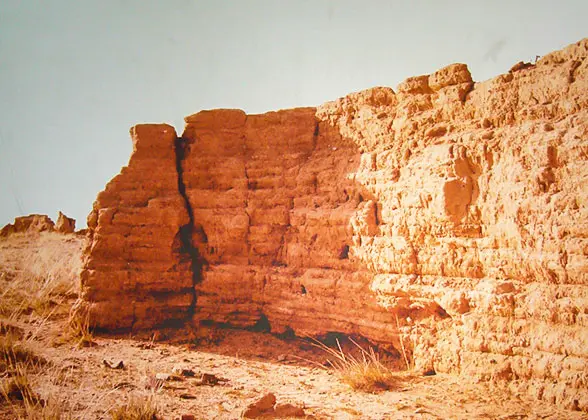 |
| Great Wall in Inner Mongolia |
 The part in Qingshuihe County of Hohhot, which was built during the Ming Dynasty, is comparatively well-preserved, with more than 5,000 beacon towers.
The part in Qingshuihe County of Hohhot, which was built during the Ming Dynasty, is comparatively well-preserved, with more than 5,000 beacon towers.
 There are many important fortresses along the wall, such as Gaoque Fortress, Jilu Fortress, and Juyan Fortress.
There are many important fortresses along the wall, such as Gaoque Fortress, Jilu Fortress, and Juyan Fortress.
 Note: A banner is a political division in Inner Mongolia. It is similar to a county.
Note: A banner is a political division in Inner Mongolia. It is similar to a county.
The Gaoque Fortress, in Urat Rear Banner of Bayannur, is the western end of the Great Wall built by the Zhao State during the Warring States Period. It is sandwiched between the northern Dabatu Valley and the western Chagan Valley at the southern foot of Langshan Mountain. "Gaoque" literally means high gate towers. It got its name because the mountain ridges on the both sides of the fortress resemble two grand gate towers when seen from afar.
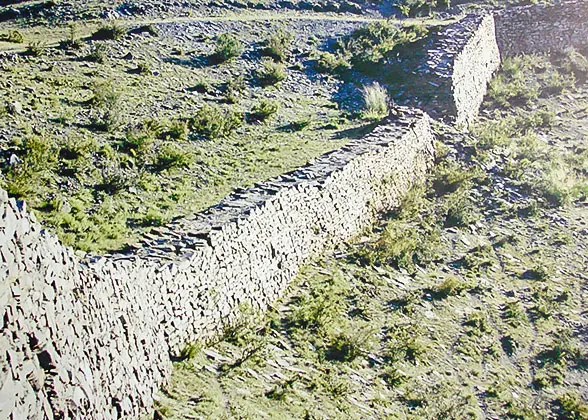 | | Wall of Qin Dynasty in Yinshan Mountain | | 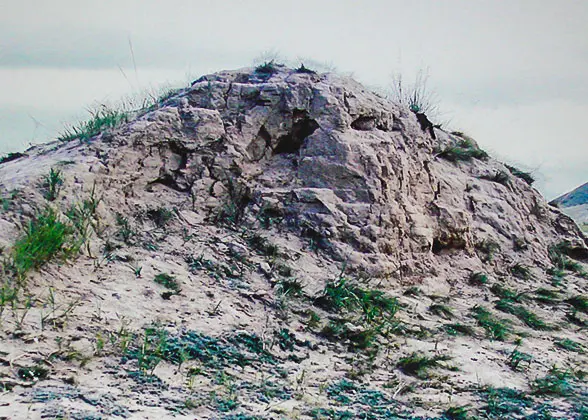 | | Wall of Zhao State in Baotou | |
The Jilu Fortress stands on the mountain slopes in northwest Dengkou County of Bayannur. It was built in 122BC during the Han Dynasty. Together with the beacon towers, stone walls, and nearby stone terraces, the fortress constituted an important military stronghold in ancient times. Also, the fortress is one of the earliest barbicans in China. In addition, the trail nearby has been proved to be part of the ancient
Silk Road.
The Juyan Fortress was constructed by the Juyan Lake in 102BC during the Han Dynasty. The relics are scattered in Ejina Banner of Alashan League, Inner Mongolia and Jinta County of Gansu Province. It is noteworthy that a considerable number of engraved wooden slips (narrow strips of wood bearing Chinese characters) have been excavated there.
Great Wall in Qingshuihe
The Qingshuihe Great Wall is 93 miles (150 kilometers) long. It crawls along the border of Qingshuihe County of Inner Mongolia, Pianguan County of Shanxi Province, and Shuozhou City of Shanxi Province. It was constructed in 1396 during the Ming Dynasty. The wall is about 26 feet (8 meters) high, and 8.7 yards (8 meters) wide. There are over 7,000 watchtowers, 5,000 beacon towers, 6 forts, and 5 passes along the wall. The best-preserved section lies between Pinglu County of Shanxi Province and Yajiao Mountain to the east of Kouzishang Village, Beibao Town, Qingshuihe County. You will be amazed by the winding wall, watchtowers, and terraces.
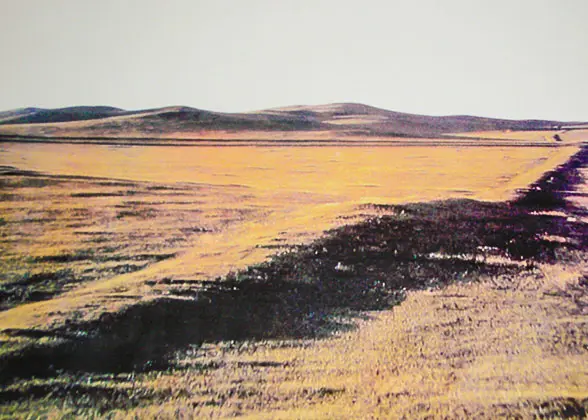 | | Wall of Jin Dynasty in Abaga Banner | | 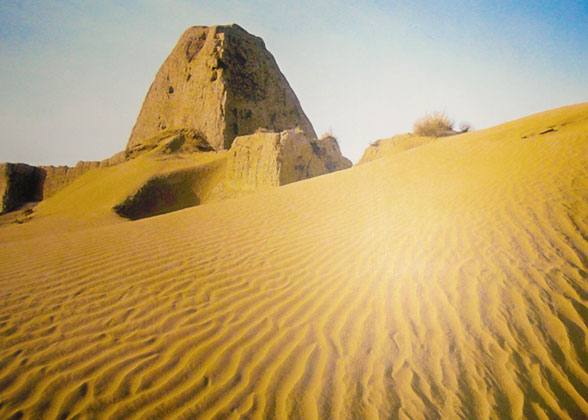 | | Wall of Ming Dynasty in Fengtai County | |
Urgent Protection Is Needed
The Inner Mongolia Great Wall is mostly distributed on the high mountains or in remote areas. The harsh climate speeds up the erosion of this heritage. For instance, the wall in the Ala Shan Desert has been engulfed by sand, only leaving dots of beacon towers. Furthermore, the wall is threatened by human beings. For example, locals demolished the Zhao State wall in Xingsheng Town, Jiuyuan District of Baotou. The relatively well-preserved Ming Dynasty wall in Ulanqab was cut in the middle for a road. These sad stories remind us of the urgency of protecting the wall.
Fortunately, the local herdsmen have founded protection teams. They ride horses or camels to the areas which are inaccessible to vehicles to reinforce the collapsing wall and beacon towers, take photos, and record data. Yet, more work needs to be done. Let's act now to protect these cultural relics, so later generations can enjoy them.

Further Reading:
Inner Mongolia Travel Guide- Last updated on Jun. 11, 2025 by Gabby Li -
![]() The 4,704-mile-long Great Wall is widely distributed in 76 counties and banners of 12 cities and leagues.
The 4,704-mile-long Great Wall is widely distributed in 76 counties and banners of 12 cities and leagues.![]() It was built during many historical periods from the Spring and Autumn Period (770 BC-476 BC) through the Ming Dynasty (1368-1644).
It was built during many historical periods from the Spring and Autumn Period (770 BC-476 BC) through the Ming Dynasty (1368-1644).![]() The most important sections were built by the Zhao State during the Warring States Period (475 BC-221 BC), Qin Dynasty (221 BC-227 BC), Han Dynasty (202 BC-220 AD), and Ming Dynasty.
The most important sections were built by the Zhao State during the Warring States Period (475 BC-221 BC), Qin Dynasty (221 BC-227 BC), Han Dynasty (202 BC-220 AD), and Ming Dynasty.
![]() The part in Qingshuihe County of Hohhot, which was built during the Ming Dynasty, is comparatively well-preserved, with more than 5,000 beacon towers.
The part in Qingshuihe County of Hohhot, which was built during the Ming Dynasty, is comparatively well-preserved, with more than 5,000 beacon towers.![]() There are many important fortresses along the wall, such as Gaoque Fortress, Jilu Fortress, and Juyan Fortress.
There are many important fortresses along the wall, such as Gaoque Fortress, Jilu Fortress, and Juyan Fortress.![]() Note: A banner is a political division in Inner Mongolia. It is similar to a county.
Note: A banner is a political division in Inner Mongolia. It is similar to a county.


